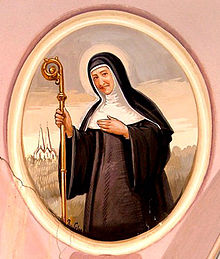Mechthild of Hackeborn
| Saint Mechtilde | |
|---|---|

Mechtilde of Hackeborn
|
|
| Born | c.1241 Helfta |
| Died | 19 November 1298 Helfta |
| Venerated in | Roman Catholicism |
| Feast | 19 November |
| Attributes | Scales and a sword |
| Patronage | Against blindness |
Saint Mechtilde of Hackeborn (1240/1241 – 19 November 1298) was a Saxon Christian saint (from what is now Germany) and a Benedictine nun. In the modern Benedictine calendar, her feast is celebrated on the anniversary of her death, November 19. She died in the monastery of Helfta.
Born Matilda von Hackeborn-Wippra, in 1240 or 1241, she belonged to one of the noblest and most powerful Thuringian families; her sister was the illustrious Abbess Gertrude of Hackeborn. The family of Hackeborn belonged to a dynasty of Barons in Thuringia who were related to the Hohenstaufen family and had possessions in northern Thuringia and in the Harz Mountains. Some writers have considered that Mechtilde von Hackeborn and Mechtilde von Wippra were two distinct persons, but, as the Barons of Hackeborn were also Lords of Wippra, it was customary for members of that family to take their name indifferently from either, or both of these estates. So fragile was she at birth, that the attendants, fearing she might die unbaptized, hurried her off to the priest who was just then preparing to say Mass. He was reported as a person of "great sanctity," and after baptizing the child, is reported to have made a statement to this effect, judged by some to be prophetic: "What do you fear? This child most certainly will not die, but she will become a saintly religious in whom God will work many wonders, and she will end her days in a good old age."
When Mechtilde was seven years old, having been taken by her mother on a visit to her elder sister Gertrude, at that time a nun in the Cistercian monastery in Rodersdorf, she became so enamoured of the cloister that her pious parents yielded to her requests and allowed her to enter the alumnate. Here, being highly gifted in mind as well as in body, she made remarkable progress in virtue and learning.
Ten years later (1258) she followed her sister, who, now abbess, had transferred the monastery to an estate at Helfta given her by her brothers Louis and Albert. As a nun, Mechtilde was soon distinguished for her humility, her fervour, and that extreme amiability which had characterized her from childhood and which, like piety, seemed almost hereditary in her clan. She joined the convent and eventually became the headmistress of the convent school. Mechtilde was employed in the convent looking after the library, illuminating scripts, and writing her own texts in Latin. Mechtilde wrote many prayers. In 1261, the abbess committed to her care a child of five who was destined to shed glory and fame upon the monastery of Helfta. This was Gertrude who in later generations became known as St. Gertrude the Great.
...
Wikipedia
